Bulletin – June 2016 Global Economy China's Demographic Outlook
- Download the article 300KB
Abstract
The significant increase in the working-age portion of China's population over recent decades was an important contributor to China's rapid economic growth. In coming decades, however, China's working-age population is expected to contract and the dependency ratio, which is the ratio of non-working-age to working-age population, is expected to increase substantially. Other things being equal, such demographic changes will have fiscal implications and tend to reduce the economy's potential growth rate. Scenarios presented in this article suggest that it appears inevitable that China's dependency ratio will rise and the working-age population will not increase from current levels. As such, the boost to economic growth provided by the demographic dividend of the past decades is not likely to be repeated.
Introduction
The fertility rate in China began declining in the 1950s and in the late 1970s the Chinese authorities introduced the one-child policy, which limited the number of children that many families could have, especially in urban areas.[1] This policy is likely to have reinforced the decline in the fertility rate, although it is difficult to quantify its effect given the downward trend in fertility already in train. Due to the substantial fall in China's fertility rate since the 1950s, cohorts born recently are smaller in number than the cohorts that are now of working age, and so the working-age population has grown large relative to the rest of the population (Graph 1).
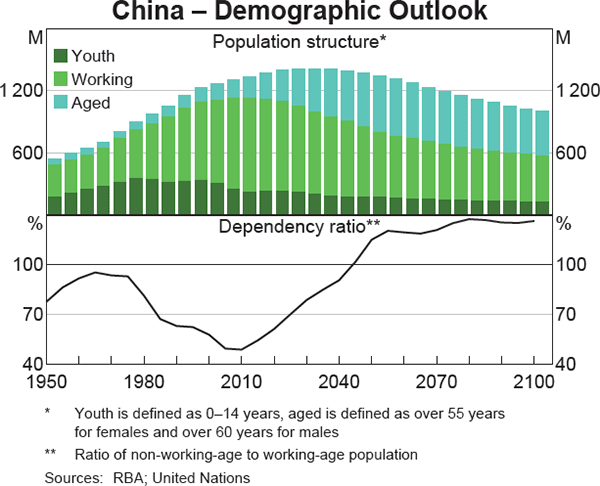
Given the population dynamics, China's dependency ratio, which is defined as the ratio of non-working-age (dependent) population to working-age population, began declining in the 1960s and reached a minimum around 2010.[2] This, combined with the increase in the working-age population, is likely to have helped increase China's potential output growth. Not only did China's potential labour input increase over that period, but the decline in the dependency ratio underpinned a relatively high savings rate, supporting investment and potentially raising the rate of economic growth (see Golley, Tyers and Zhou (2016)). It has been argued that a large part of China's growth over the past 30 years can be attributed to this so called ‘demographic dividend’ (Cai and Lu 2013). In addition to its impact on potential output and economic growth, the decline in the dependency ratio had large fiscal implications, particularly for the pension, healthcare and education systems (Lee, Xu and Syed 2013). A relatively large working-age population has provided higher income tax revenues to fund such systems and has been less dependent on these systems' services, at least so far.
China's dependency ratio in 2015 was 55 per cent, meaning that there were around 55 dependent persons per 100 working-age persons. Of these dependants, half were younger than working age and half were older. China's dependency ratio is currently low compared with that in Australia and other Asian economies, but this is not expected to remain the case. In coming decades, China's dependency ratio is projected by the United Nations (UN) to increase at a similar rate to Japan's, overtaking Australia in around 2040 and remaining around 80–90 per cent from 2060 onwards (Graph 2). This means that there will be almost twice as many dependants per working-age person in China as there are now. In addition, the working-age population peaked in 2010 and is expected to continue to decline. The Chinese authorities have acknowledged the challenges posed by these demographic changes and policy responses are in train. This article considers a range of scenarios for the fertility rate and the retirement age, and the likely effect on the outlook for China's demographic structure over the next century.[3]
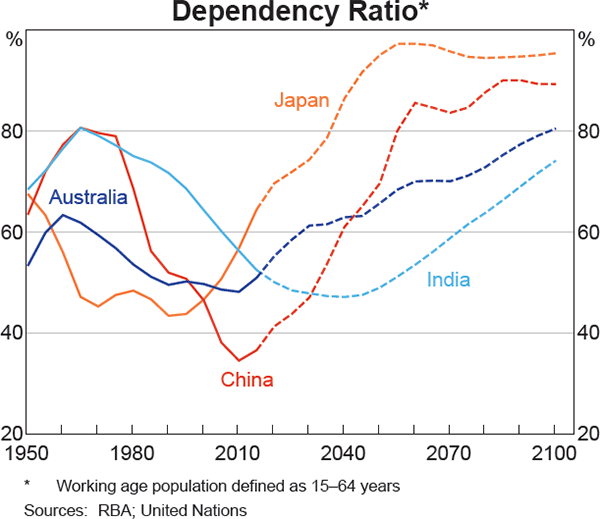
Changes in the Fertility Rate
China's fertility rate, at 1.6 births per woman, is among the lowest in the world (UN 2015).[4] To ‘balance population development and address challenges associated with an ageing population’, the State Council announced in 2015 that it would formally end the one-child policy, allowing all couples to now have two children (Bao 2015).[5]
While it is not immediately clear what impact this will have on the fertility rate, we investigate the impact of potential changes using UN projection scenarios for ‘low’, ‘medium’ and ‘high’ fertility rates in China out to 2100 (Graph 3).[6] Under all the fertility scenarios, China's working-age population declines at a similar rate over the next few decades, and is lower over the next 100 years than it is now. The dependency ratio rises before flattening out around 2080 for all scenarios (Graph 4).
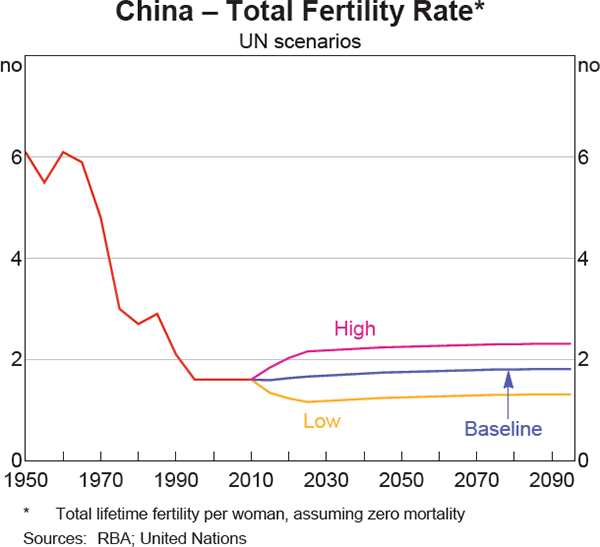
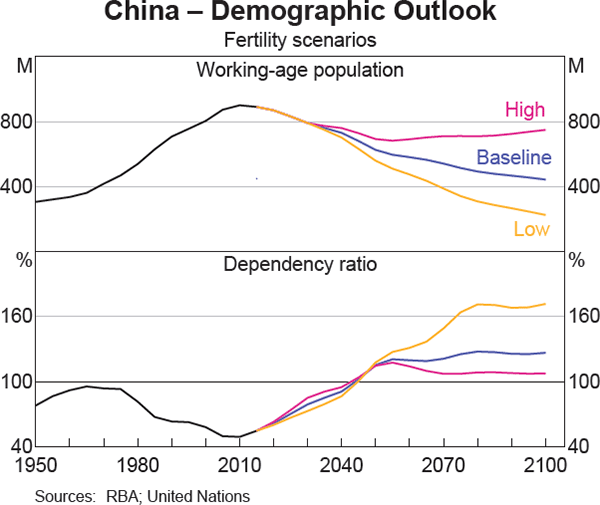
- Under the ‘medium’ scenario, the fertility rate is 1.6 births per woman in 2015 (in line with official estimates) and rises only slightly over the projection period. This is used as our baseline scenario. The working-age population declines persistently over the projection period and the dependency ratio rises.
- Under the ‘high’ scenario, the fertility rate is 1.8 in 2015, and rises and stabilises at slightly above 2.1 (often called the ‘population replacement fertility rate’). The working-age population declines initially but rises after 2055 as the larger youth cohorts reach working age. The dependency ratio initially rises to be higher than under the baseline scenario but falls below it in the long term. This is because the higher fertility rate leads to an increase in the youth population, which raises the dependency ratio until these cohorts enter the working-age population.[7]
- Under the ‘low’ scenario, the fertility rate falls from 1.3 in 2015 but then rises a little over the projection period. The working-age population declines at a faster rate compared to the baseline scenario. The dependency ratio is initially lower than under the baseline scenario, but rises to be well above it towards to the latter part of the century.
The three scenarios are based on UN projections for fertility rates, but are not all equally likely. In particular, there is evidence to suggest that the high-fertility scenario is less likely to materialise in practice as it relies on a positive response from the relaxation of the one-child policy. This is unlikely because much of the decline in the fertility rate since the 1970s appears to reflect forces unrelated to China's fertility policies. Indeed, much of the decline in China's fertility rate had already begun before the one-child policy was introduced, and fertility rates have declined in many countries without such strict policies (Graph 5). While fertility in China declined at a comparatively fast rate, it is likely that the decline in part reflects a global trend towards smaller families. Consistent with this, official data and survey-based estimates for China suggest that the one-child policy has not been a binding constraint for most couples in recent years.[8] Reasons cited for preferring a smaller family include the high opportunity costs for childbearing females and lack of sufficient childcare facilities. These factors suggest that, while the authorities may aim to encourage higher fertility by relaxing family planning policies, China is unlikely to experience a substantial increase in fertility rates unless other structural issues are addressed.[9]
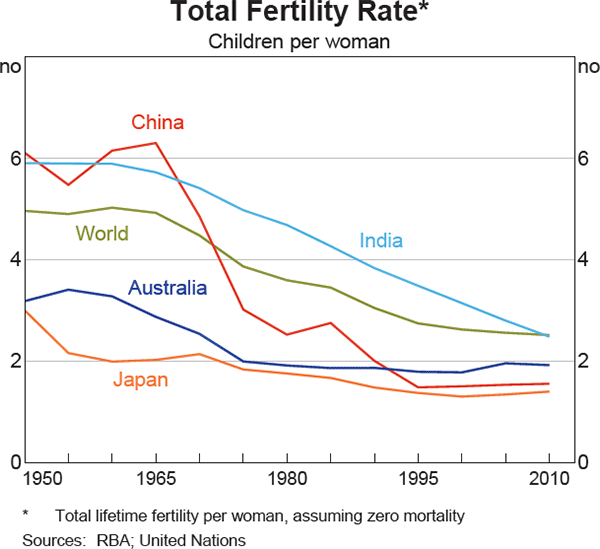
Increase in the Retirement Age
Another policy lever available to the Chinese authorities to address the challenges associated with the ageing population is to increase the retirement age, which currently stands at 60 years for males and 50 or 55 years for females, depending on occupation.[10] These ages were set in the 1950s when life expectancy in China, conditional on reaching 60 years of age, was around 70 years.[11] This is much lower than the current life expectancy of 80 years and the UN projections of around 85 years in 2050 and 91 years in 2100. In 2015, the authorities announced their intention to gradually increase the retirement age, allowing it to rise by several months per year between 2017 and 2022 (Shi et al 2015). Full details of the change will be released later this year (State Council 2016a).
One simple approach for assessing the potential impact of an increase in the retirement age is to adjust the definition of the working-age population in line with projected retirement age changes. We assume that China will increase the retirement age gradually to 65 years, for both men and women, between 2020 and 2035. The final retirement age of 65 years is in line with international standards, while the rate of adjustment implied is in line with the authorities' proposal to raise the retirement age by several months a year.
Under the medium-fertility scenario described in the previous section, an increase in the retirement age will reverse the decline in the working-age population for a period (Graph 6). However, in the long run the increase of the retirement age only delays the decline in the working-age population. The retirement age policy change has a much larger impact on the dependency ratio.[12] The dependency ratio falls slightly in the short run as the working-age population increases and, although it subsequently rises, the dependency ratio only reaches 90 per cent by 2100, compared with 125 per cent in the case of no change in the retirement age.
However, raising the retirement age in China would, as in many other countries, be unpopular. Several media reports of public surveys conducted over the past few years suggest strong public opposition to increases in the retirement age, especially from women (Wong 2015). Commonly cited concerns include the limited capability of people to work past 60 years (particularly in more physically intensive sectors such as mining) and increased difficulty for young adults to find work (Higo and Klassen 2015).
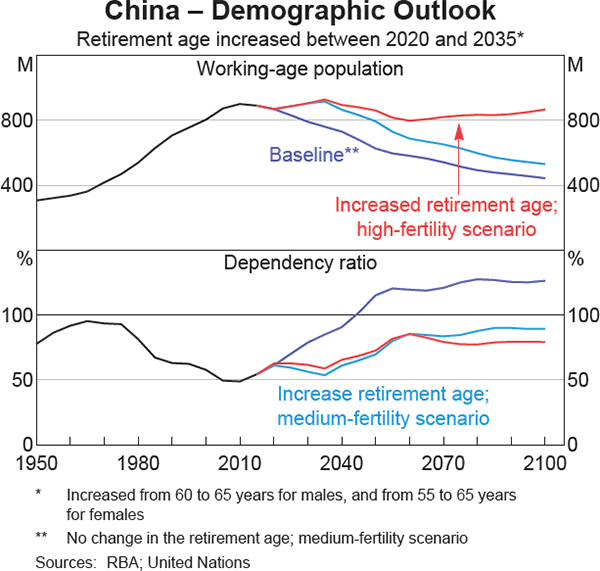
There are concerns about the impact of the change in pension eligibility for people close to the current retirement age, and it has also been claimed that China's older workers lack skills (Giles et al 2015).
Under the high-fertility scenario, an increase in the retirement age implies that the working-age population is slightly lower than the current level by 2100, and the dependency ratio would rise but stabilise at a lower level compared with the medium-fertility assumption (Graph 6). Thus, even if a higher fertility rate and later retirement age are achieved, China's working-age population is unlikely to continue to increase and its dependency ratio would be higher than its current level.
Implications of China's Demographic Outlook
In all the scenarios considered above, China's working-age population falls below the current level and the dependency ratio increases. An increasing dependency ratio, particularly when driven by aged dependency, puts pressure on the government's fiscal position through higher health and pension expenditure and lower income tax revenues (due to a smaller tax base) than otherwise.
Even though the dependency ratio eventually reaches a similar level to that of the 1970s, under the increased retirement age scenario, its composition is very different. In 2100, aged dependants are the main contributor to the high dependency ratio, as opposed to youth dependants in the 1970s (Graph 7).[13] It is difficult to estimate public expenditure per capita on the youth versus the aged in China, but international estimates suggest that public expenditure on the aged (such as pensions and health services) typically exceeds expenditure on the youth population (such as education services) (Isaacs 2009).
The International Monetary Fund (IMF) has estimated that China's pension expenditure was 3.4 per cent of GDP in 2010 and will increase to 9 per cent by 2050 due to the ageing of the population (IMF 2011).[14] The current pension system is primarily managed by local governments and there have been reports of underfunding due to high legacy costs.[15] In some cases, the central government has had to intervene with subsidies to offset the shortfalls in these local government pension systems; an ageing population will add further pressure (Pozen 2013). Already a substantial number of aged people report that they are financially reliant on their families, so working-age adults, particularly from one-child families, may come under increasing financial strain as their parents age.[16] In addition, an ageing population will place pressure on healthcare services, creating demand for a more comprehensive system of long-term care for the elderly (Feng et al 2012).
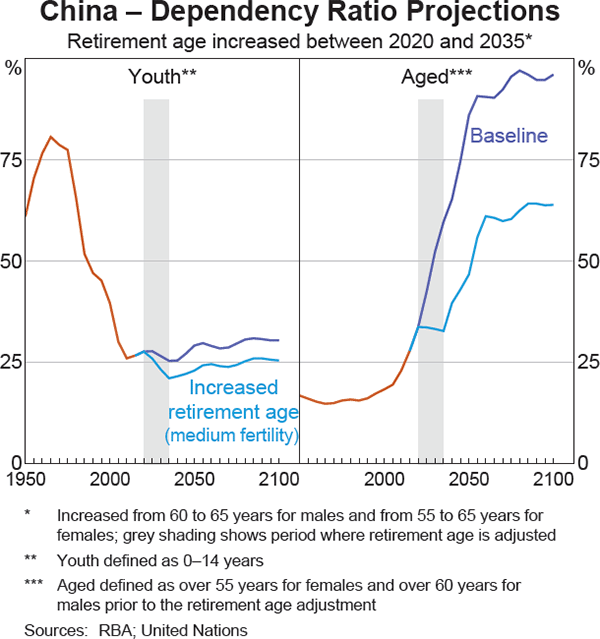
A declining working-age population and increasing dependency ratio will, other things being equal, place downward pressure on China's potential growth rate by reducing the labour supply and lowering the extent of saving, which in turn may affect the ability to fund investment. One way to offset the impact on potential growth would be to improve productivity. Initiatives, such as increasing the gross enrolment rate in higher education, could help facilitate an increase in workforce productivity (World Bank and DRC 2014).[17] Moreover, China's urbanisation rate is expected to increase from around 55 per cent in 2015 to 80 per cent by 2050, and the shifting of resources away from lower-productivity rural activities could further support total productivity growth (Annez and Buckley 2008).
Raising participation rates is another way to offset the effect of a declining working-age population on potential labour supply and growth. Participation rates in China are estimated to vary considerably by gender, age, education, and urban or rural location. For example, women currently have lower participation rates than men, and policies that increase women's participation could help reduce the downward pressure on the labour force (World Bank 2016).[18] Increasing time spent in education will reduce the participation rate of younger persons, but may improve their productivity once they enter the labour force and increase participation throughout their lives (Lu and Cai 2014).
Conclusion
A range of scenarios suggest that China's working-age population will not increase and that the dependency ratio will rise over the next few decades. The scenarios considered suggest that an increased fertility rate would be most effective in eventually stopping the decline in the working-age population, while a sizeable increase in the retirement age would have a more immediate and significant impact on the dependency ratio. As a large increase in China's fertility rate appears unlikely in light of the downward trend in fertility rates (which appears to be, at least in part, independent of the one-child policy), efforts to increase the retirement age may be more effective in addressing China's demographic challenges in the period ahead. However, even an increase in the retirement age is unlikely to be straightforward to implement.
The policies discussed here – even if successfully implemented – are not likely to reverse the trend of an increasing dependency ratio and declining working-age population in the longer run. The demographic dividend provided China with a one-off boost to growth and it is likely that growth in the future will need to be driven by productivity, which would benefit from further reform.
Footnotes
The authors are from Economic Group. This work benefited from earlier internal work undertaken within Economic Group by Alex Cooper. [*]
The main goal of China's one-child policy was to curb population growth. While the details and implementation of the policy varied over time and depended somewhat on specific circumstances, the authorities typically encouraged couples to have one child by providing financial and other incentives, such as preferential access to education and health services, and by imposing financial levies or other penalties for each additional child after the first. There were numerous exemptions to the policy, which often applied in rural areas and for ethnic minorities (Kane and Choi 1999). [1]
China's working-age population is taken to be all males aged 15 to 59 years and all females aged 15 to 55 years, reflecting current retirement age policies. [2]
UN estimates suggest the net international migration rate is currently around zero, and is projected to remain there over the projection horizon. In our scenario analysis we ignore the impact of migration on the population. [3]
While a fertility rate of 1.6 births per woman is in line with official estimates, some demographers estimate it to be slightly lower, at around 1.3 (Cai and Du 2009; NHFPC 2013). China's fertility rate has remained higher than 1 birth per woman, despite the one-child policy, because it did not cover all couples (see footnote 1). The effective coverage of the policy was estimated to be around 63 per cent of the total population in 2000 (East-West Center 2005). [4]
In 2013, the policy was relaxed so that families would be permitted to have two children if either parent was a single child (NPC 2013). In 2015, the one-child policy was formally abolished; all couples are now allowed to have two children (Bao 2015). [5]
The three scenarios presented here are based on UN projections for fertility rates, which we take as given. Not only is there uncertainty around these projections, but the scenarios are not equally likely, and the UN does not specify the expected likelihood of the three scenarios. [6]
Research finds that, in the long run, a higher fertility rate, which boosts labour supply, will tend to slow the decline in potential growth (Lu and Cai 2014; Cai and Roberts 2015). [7]
Less than 15 per cent of eligible couples applied to have a second child in the 18 months after the one-child policy was relaxed in late 2013 (Shan 2015). A range of studies conducted between 2000 and 2010 suggested that mean fertility preferences were 1.5 births per woman in urban areas and 1.8 in rural areas, which suggests a national average around 1.6, close to official estimates of the current fertility rate. [8]
While the authorities have not stated their estimates of the effect of the end of the one-child policy on the fertility rate, official estimates suggest that with the relaxation, only 17 million of the 90 million newly eligible couples will have a second child, contributing to an additional 30 million people joining the workforce by 2050 (Shan 2016; Wang 2015). [9]
The retirement age is 60 years for men, 55 years for female white-collar workers and 50 years for female blue-collar workers (State Council 2016b). [10]
Life expectancy at birth in the 1950s was around 45 years. [11]
While the results are sensitive to the final retirement age chosen and the speed of adjustment, in all scenarios any increase in the retirement age slows the rise of the dependency ratio. For example, one option is to increase the retirement age to 65 years in 2035, after which the retirement age increases at the same rate as life expectancy. Under this scenario the rise of the dependency ratio slows markedly, with the dependency ratio reaching around 70 per cent at the end of the projection period, compared with 90 per cent when no adjustment is made to account for increased life expectancy after 2035. [12]
The youth dependency ratio is calculated as the ratio of the youth population to the working-age population. The aged dependency ratio is calculated as the ratio of the aged population to the working-age population. [13]
In the absence of detailed information about pension reform in China, the projections are based on assumptions such as a constant coverage ratio and constant replacement rate. The IMF's estimates for China are similar to that of Oksanen (2010), which assumes that the generosity of public pensions remains at the current level. [14]
For example, legacy costs include payments to state sector employees who were not required to make pension contributions prior to 1997. [15]
In urban areas, around 37 per cent of aged persons surveyed reported that family support was their main source of income while 45 per cent stated that pensions were their main source of income. In rural areas, 54 per cent reported family support as their main source of income, while 5 per cent stated that it was pensions (Dorfman et al 2013). [16]
China's higher-education gross enrolment rate was around 30 per cent in 2012. The authorities have stated that their aim is to achieve a rate of 40 per cent by 2020 (MOE 2010). [17]
Estimates of female participation rates are based on data from the China Health and Retirement Longitudinal Study. [18]
References
Annez PC and RM Buckley (2008), ‘Urbanization and Growth: Setting the Context’, in M Spence, PC Annez and RM Buckley (eds), Urbanization and Growth, Commission on Growth and Development, World Bank Publications, Washington DC, pp 1–46.
Bao D (2015), ‘Couples Allowed to have 2 Children’, State Council, viewed 1 November 2015. Available at <http://english.gov.cn/news/top_news/2015/10/30/content_281475223354250.htm>.
Cai F and I Roberts (2015), ‘Potential Growth and Rebalancing in China’, RBA Bulletin, June, pp 29–37.
Cai F and Y Du (eds) (2009), The Approaching Lewis Turning Point and Its Policy Implications, The China Population and Labor Yearbook, Volume 1, BRILL, Leiden.
Cai F and Y Lu (2013), ‘The End of China's Demographic Dividend: The Perspective of Potential GDP Growth’, in R Garnaut, F Cai and L Song (eds), China: A New Model for Growth and Development, ANU E Press, Canberra, pp 55–74.
Dorfman MC, R Holzmann, P O'Keefe, D Wang, Y Sin and R Hinz (2013), China's Pension System: A Vision, Directions in Development: Human Development, World Bank, Washington DC, p 237.
East-West Center (2005), ‘Can China Afford to Continue Its One-Child Policy?’, Asia Pacific Issues, No 77, March.
Feng Z, L Chang, X Guan and V Mor (2012), ‘China's Rapidly Aging Population Creates Policy Challenges in Shaping a Viable Long-term Care System’, Health Affairs, 31(12), pp 2764–2773.
Giles J, X Lei, Y Wang and Y Zhao (2015), ‘One Country, Two Systems: Evidence on Reitrement Patterns in China’, Asian Bureau of Finance and Economic Research Working Paper, February.
Golley J, R Tyers and Y Zhou (2016), ‘Contractions in Chinese Fertility and Savings: Long Run Domestic and Global Implications’, Paper presented at the Reserve Bank of Australia Conference, ‘Structural Change in China: Implications for Australia and the World’, Sydney, 17–18 March.
IMF (International Monetary Fund) (2011), ‘The Challenge of Public Pension Reform in Advanced and Emerging Economies ‘, Policy paper prepared by the Fiscal Affairs Department, 28 December.
Isaacs JB (2009), ‘A Comparative Perspective on Public Spending on Children’, Brookings Centre on Children and Families Working Paper, November.
Kane P and Y Choi (1999), ‘China's One Child Family Policy’, British Medical Journal, 319(7215), pp 992–994.
Lee IH, Q Xu and M Syed (2013), ‘China's Demography and its Implications’, IMF Working Paper WP/13/82.
Lu Y and F Cai (2014), ‘China's Shift from the Demographic Dividend to the Reform Dividend’, in L Song, R Garnaut and F Cai (eds), Deepening Reform for China's Long-term Growth and Development, China update series, ANU Press, Canberra, pp 27–50.
McIntosh B and C Zhang (2015), ‘Ageing Challenges in China's Workforce: Demographic Projections, Labour Market Dynamics and Solutions’, in M Higo and TR Klassen (eds), Retirement in Japan and South Korea: The Past, the Present and the Future of Mandatory Retirement, Routledge, New York, pp 129–147.
MOE (Ministry of Education of the People's Republic of China) (2010), ‘China's New National Education Plan Aims to Build A Country with Rich Human Resources’, 30 July. Available at <http://www.moe.edu.cn/publicfiles/business/htmlfiles/moe/s3501/201010/109031.html>.
NHFPC (National Health and Family Planning Commission of the People's Republic of China) (2013), ‘Statement of National Health and Family Planning Commission of China’, 19 November. Available at <http://www.nhfpc.gov.cn/jczds/s3578/201311/f852a9d6833d4c1eb79b9e67f1885416.shtml>.
NPC (The National People's Congress of the People's Republic of China) (2013), ‘China Reviews Bill to Ease One-Child Policy’, 24 December. Available at <http://www.npc.gov.cn/englishnpc/news/2013-12/24/content_1819669.htm>.
Oksanen H (2010), ‘The Chinese Pension System: First Results on Assessing the Reform Options’, Economic Papers 412, June.
Pozen C (2013), ‘Tackling the Chinese Pension System’, Paulson Policy Memorandum, July.
Shan J (2015), ‘Family Planning Policy Sees Big Overhaul’, State Council, viewed 10 November 2015. Available at <http://english.gov.cn/news/top_news/2015/10/30/content_281475223356896.htm>.
Shan J (2016), ‘Two-Child Policy to Create 30m More Workers by 2050’, China Daily, viewed 15 January 2016. Available at <http://www.chinadaily.com.cn/china/2016-01/11/content_23032394.htm>.
Shi R, H Xu, B Zhang and J Yao (2015), ‘Slowly, China Prepares to Raise Retirement Age’, Caixin Online, viewed 10 January. Available at <http://english.caixin.com/2015-04-01/100796734.html>.
State Council (The State Council, the People's Republic of China) (2016a), ‘China to Unveil Retirement Age Plan in 2016’, 29 February. Available at <http://english.gov.cn/news/top_news/2016/02/29/content_281475298711664.htm>.
State Council (2016b), ‘China Plans to Raise Age of Retirement’, 1 March. Available at <http://english.gov.cn/state_council/ministries/2016/03/01/content_281475299145295.htm>.
UN (United Nations) (2015), ‘World Population Prospects: The 2015 Revision’, Comprehensive Dataset in Excel, 29 July.
Wang X (2015), ‘90m More to be Eligible for 2nd Child’, China Daily, 11 November. Available at <http://www.chinadaily.com.cn/china/2015-11/11/content_22425704.htm>.
Wong CH (2015), ‘Selective Inequality? China Retirement Age Plan Sparks Backlash among Women’, China Real Time, 1 December. Available at <http://blogs.wsj.com/chinarealtime/2015/12/03/selective-equality-china-retirement-age-plan-sparks-backlash-among-women>.
World Bank (2016), Live Long and Prosper: Aging in East Asia and Pacific, World Bank East Asia and Pacific Regional Reports, World Bank, Washington DC, p 287.
World Bank and DRC (World Bank and Development Research Center of the State Council, the People's Republic of China) (2014), Urban China : Toward Efficient, Inclusive, and Sustainable Urbanization, World Bank, Washington, DC.